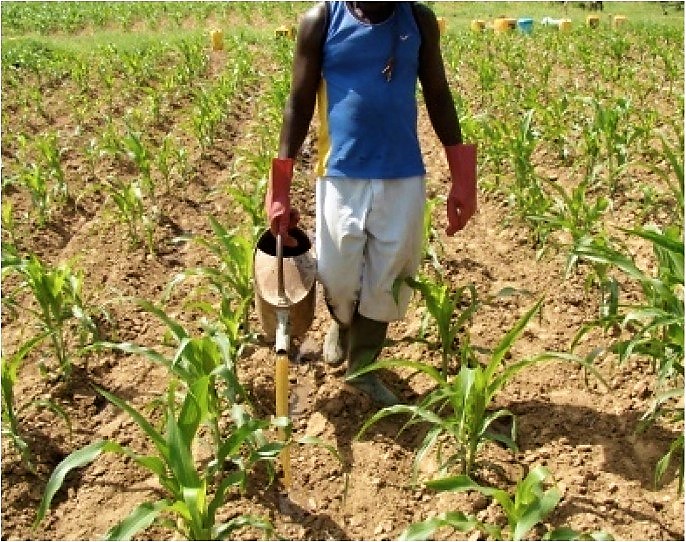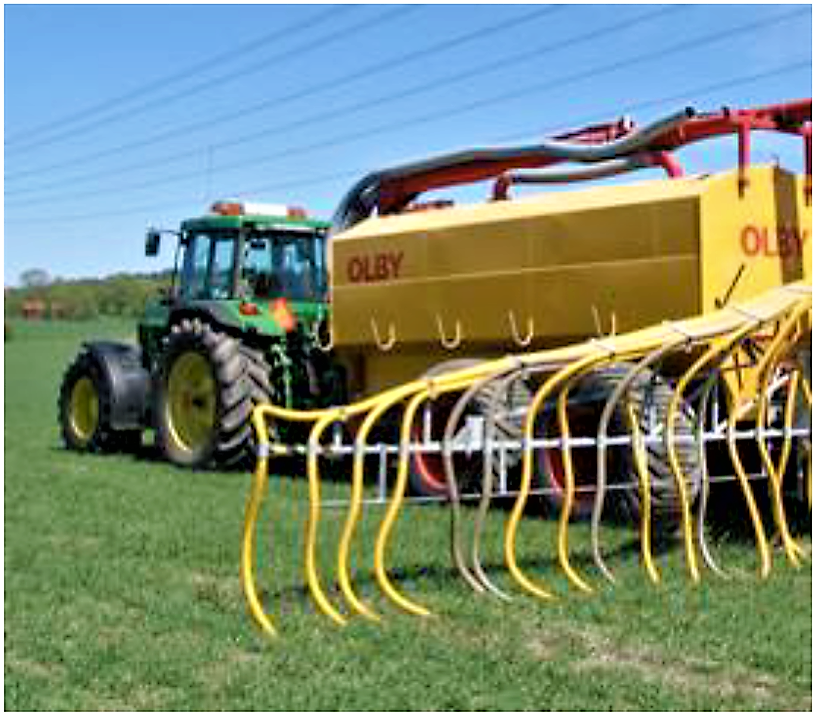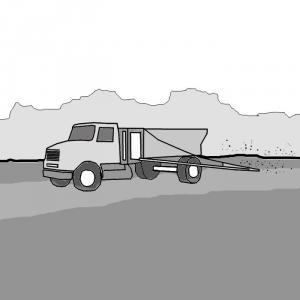Executive Summary
Separately collected and hygienised urine is a concentrated source of nutrients which can be applied as a liquid fertilizer in agriculture to replace or complement commercial chemical fertilizer. Large-scale urine use refers to the application of urine that is collected from a substantial number of households and transported for the application of larger agricultural areas. Therefore it requires a higher level of transport, storage and application infrastructure.
| In | Out |
|---|---|
Urine, Yellowwater, Fertiliser |
Food Products |
Basic Information
Urine is a liquid product of the human body that is secreted by the kidneys. A big share of the soluble substances in urine consists of essential plant nutrients like Nitrogen (N), Phosphorus (P) and Potassium (K) that can be easily reused in agriculture. There is almost a mass balance between nutrient consumption and excretion, but the actual nutrient content in urine is of course dependent on the diet and varies between countries as well as between individuals.
The amount of urine produced per person and day depends on the amount of liquid a person drinks, but usually lies within a range of 0.8 to 1.5 L per day for an adult person and about half as much for children, respectively (WHO 2006). On average, an adult person produces around 500 L (550 kg) of urine per year, thus approximately 4 kg of N, 0.5 kg of P and 1 kg of K per person per year (JOENSSON et al. 2004). Urine can therefore be considered as a nitrogen rich liquid fertiliser. Due to its comparably high N and low organic matter content it is often recommended to complement urine application with other nutrient and organic matter sources.
In respect of the 0.5 kg of phosphorus, and taking into account fertiliser prizes from the Nepalese market in 2008 (35 NRs/kgNPK fertiliser (ratio 20:20:10), GANTENBEIN 2009), this is thus equivalent to 1.2$ per capita per year and 9$ if we consider a family equivalent to 7 adult members. That does not seem much on a first sight – but it’s the scale that makes the difference. If you take for instance a city with a population of 1.5 million, the value of the generated urine is 1.8 million $ per year.
In larger scale systems where urine is collected from several households, urine should be stored for at least 6 months before considered safe for agricultural use (WHO 2006). You can find more information on the hygienisation of urine through storage in the factsheet regarding storage of urine.


The storage of large quantities of urine can be a difficult logistic problem and should be well organised and prepared. In the view of a large scale application of the stored liquid as a fertiliser (and eventually a commercialisation of the product), at least some samples of different storage containers should be analysed from time to time to guarantee a good hygienisation and fertiliser quality.
Special attention has to be paid to sealing the storage containers: when urea is degraded to ammonium, the pH of the solution rises. Even though higher pH implicates a faster inactivation of pathogenic microorganisms (SCHOENNING 2004) it also means that nitrogen can evaporate as ammonia (JOENSSON et al. 2004).
Because of its high nitrogen content, urine should be applied at a rate corresponding to the desired plant nitrogen requirements. A starting point for dimensioning urine application are local recommendations for use of mineral nitrogen fertilisers.
Urine can be applied neat or diluted with water. The existing recommendations vary widely, depending on the local conditions. A common and often recommended dilution rate is 1:3 (1 part urine with 3 parts of water). It should be considered that dilution increases the volume to be spread and thus labour, transport expense, equipment needed etc. Yet, the advantages of dilution include a noticeable odour reduction and a decreased risk of over-application.
For the best fertilising effect and to avoid ammonia losses to the air, urine should be incorporated into the soil as soon as possible after application, preferably instantly. A low-cost method is the relatively labour-intensive application with watering cans (see picture). Another option is the close to the ground application of urine with slurry spreaders (see picture) or the application of urine with drip irrigation systems. The mix of the urine with flooding irrigation water for rice production has also been tested. When spreading urine, it should not be applied on leaves or other parts of the plants, as this can cause foliar burning.


A good availability of nutrients is particularly important in the early stages of cultivation. Once the crop enters its reproductive stage, it normally stops growing and hardly takes up any more nutrients. Fertilizations should stop after between 2/3 and 3/4 of the time between sowing and harvest. A waiting period of one month between fertilization and harvest should always be observed.
An important challenge for the sustainability of large-scale urine handling systems is to minimise the costs for transport, storage, and application towards the goal that no subsidies are needed. Depending on the acceptance among the population (both farmers and end-product consumers) and the local fertiliser market prices, farmers might be willing to pay for hygienised human urine. In the absence of any alternative treatment or disposal for urine (and excreta), the households or governmental structures might be prepared to contribute to the financing of urine collection, storage and redistribution infrastructure as a sustainable and integrated sanitation and food security approach.
Health risks associated with the use of human urine in plant production are generally low. However, during the source separation, faecal cross-contamination can occur and respective measures to reduce potential health risks to an acceptable minimum following the WHO multi-barrier strategy should always be considered.
Urine is especially beneficial where there is a lack of nitrogen, or for crops that consume a lot of nitrogen, e.g.: maize, rice, millet, sorghum, yam, manioc, wheat, chard, turnip, carrots, kale, cabbage, lettuce, bananas, paw-paw, oranges and many others. Large scale urine application is ideal for rural and peri-urban areas where agricultural lands are relatively close to the point of urine collection. In larger scale systems urine needs to be collected at a semi-centralised location for distribution and transport to agricultural land.
When deciding on larger-scale application of urine in agriculture, the handling infrastructure and particularly the transport of urine from the point of origin to the field needs to be considered. Also storage during a sufficient amount of time has to be guaranteed in order to prevent health risks. Regardless of this, the most important aspect is that there is a need for nutrients – otherwise the urine can become a source of pollution and nuisance if dealt with improperly.
Struvite Recovery from Urine at Community Scale in Nepal Final Project Report Phase I.
Guidelines on the Use of Urine and Faeces in Crop Production
These guidelines provide a thorough background on the use of urine (and faeces) for agricultural purposes. Aspects discussed are requirements for plant growth, nutrients in excreta, hygiene aspects, and recommendations for cultivation. It provides detailed guidance on the use of urine for purposes.
JOENSSON, H. RICHERT, A. VINNERAAS, B. SALOMON, E. (2004): Guidelines on the Use of Urine and Faeces in Crop Production. (= EcoSanRes Publications Series , 2004 ). Stockholm: EcoSanRes URL [Accessed: 17.04.2012]Guidelines for the Safe Use of Urine and Faeces in Ecological Sanitation Systems
These guidelines provide a thorough background on the safe use of urine and faeces for agricultural purposes. Aspects like the health risk associated we the use of human excreta in agriculture and how to limit them are discussed.
SCHOENNING, C. STENSTROEM, T. A. (2004): Guidelines for the Safe Use of Urine and Faeces in Ecological Sanitation Systems. (= EcoSanRes Publication Series, Report 2004-1 ). Stockholm: Stockholm Environment InstituteCompendium of Sanitation Systems and Technologies
This compendium gives a systematic overview on different sanitation systems and technologies and describes a wide range of available low-cost sanitation technologies.
TILLEY, E., LUETHI, C., MOREL, A., ZURBRUEGG, C. and SCHERTENLEIB, R. (2008): Compendium of Sanitation Systems and Technologies. Duebendorf, Switzerland: Swiss Federal Institute of Aquatic Science and Technology (EAWAG) and Water Supply and Sanitation Collaborative Council (WSSCC) URL [Accessed: 15.02.2010] PDFGuidelines for the safe use of wastewater excreta and greywater. Volume IV. Excreta and Greywater Use in Agriculture
Volume IV of the Guidelines for the Safe Use of Wastewater, Excreta and Greywater recognizes the reuse potential of wastewater and excreta (including urine) in agriculture and describes the present state of knowledge as regards potential health risks associated with the reuse as well as measures to manage these health risks following a multi-barrier approach.
WHO (2006): Guidelines for the safe use of wastewater excreta and greywater. Volume IV. Excreta and Greywater Use in Agriculture. Geneva: World Health Organisation (WHO) URL [Accessed: 09.05.2019] PDFLarge Scale Handling of Urine and Faeces
Urine and Faeces as Fertilizers in the CREPA Network
Presentation on experiences with the use of urine (and faeces) in agriculture including research results, conducted taste tests and calculations on the fertiliser value.
DAGERSKOG, L. SuSanA (2009): Urine and Faeces as Fertilizers in the CREPA Network. pdf presentation. (= SuSanA presentation WG , 5 ). Ouagadougou: Sustainable Sanitation Alliance URL [Accessed: 27.05.2019]Compendium of Sanitation Systems and Technologies (Arabic)
This is the Arabic version of the Compendium of Sanitation Systems and Technologies. The Compendium gives a systematic overview on different sanitation systems and technologies and describes a wide range of available low-cost sanitation technologies.
TILLEY, E. ULRICH, L. LUETHI, C. REYMOND, P. SCHERTENLEIB, R. ZURBRUEGG, C. (2014): Compendium of Sanitation Systems and Technologies (Arabic). 2nd Revised Edition. Duebendorf, Switzerland: Swiss Federal Institute of Aquatic Science and Technology (Eawag) PDFGuidelines on the Use of Urine and Faeces in Crop Production
These guidelines provide a thorough background on the use of urine (and faeces) for agricultural purposes. Aspects discussed are requirements for plant growth, nutrients in excreta, hygiene aspects, and recommendations for cultivation. It provides detailed guidance on the use of urine for purposes.
JOENSSON, H. RICHERT, A. VINNERAAS, B. SALOMON, E. (2004): Guidelines on the Use of Urine and Faeces in Crop Production. (= EcoSanRes Publications Series , 2004 ). Stockholm: EcoSanRes URL [Accessed: 17.04.2012]Urine as Liquid Fertilizer in Agricultural Production in the Philippines
This field guide has been developed to accommodate the ever-increasing demand for more detailed and scientifically backed information on how to use urine in agricultural production. It is intended primarily for practitioners and experts in the water, sanitation, planning, and agriculture sectors, as well as local and national government officials from the various sectors, NGO and individuals interested and working in the field of agriculture and sustainable sanitation in the Philippines and the wider Southeast Asian region.
GENSCH, R. MISO, A. ITSCHON, G. (2011): Urine as Liquid Fertilizer in Agricultural Production in the Philippines. Cagayan de Oro: Sustainable Sanitation Center Xavier University (XU), the Philippine Sustainable Sanitation Knowledge Node, the Philippine Ecosan Network, and the Sustainable Sanitation Alliance (SuSanA) URL [Accessed: 07.05.2019]Large Scale Handling of Urine and Faeces
Guidelines for the safe use of wastewater excreta and greywater. Volume IV. Excreta and Greywater Use in Agriculture
Volume IV of the Guidelines for the Safe Use of Wastewater, Excreta and Greywater recognizes the reuse potential of wastewater and excreta (including urine) in agriculture and describes the present state of knowledge as regards potential health risks associated with the reuse as well as measures to manage these health risks following a multi-barrier approach.
WHO (2006): Guidelines for the safe use of wastewater excreta and greywater. Volume IV. Excreta and Greywater Use in Agriculture. Geneva: World Health Organisation (WHO) URL [Accessed: 09.05.2019] PDFGuidelines on the Use of Urine and Faeces in Crop Production
These guidelines provide a thorough background on the use of urine (and faeces) for agricultural purposes. Aspects discussed are requirements for plant growth, nutrients in excreta, hygiene aspects, and recommendations for cultivation. It provides detailed guidance on the use of urine for purposes.
JOENSSON, H. RICHERT, A. VINNERAAS, B. SALOMON, E. (2004): Guidelines on the Use of Urine and Faeces in Crop Production. (= EcoSanRes Publications Series , 2004 ). Stockholm: EcoSanRes URL [Accessed: 17.04.2012]Fertilisation with Urine in Agriculture – in a Nutshell
This leaflet provides a summary on why and how to fertilize with urine including brief application recommendations, hygiene considerations and trouble shooting support.
VALLEY VIEW UNIVERSITY (2008): Fertilisation with Urine in Agriculture – in a Nutshell. University of Hohenheim Germany: Berger Biotechnik and Valley View University Ghana.VUNA Final Report
"The project described in this report had three basic objectives: • Promote the use of toilets by giving urine a value; • Produce a valuable fertiliser; • Protect the environment by reducing pollution. The project was named VUNA, which means “harvest” in the isiZulu language, but which also stands for “Valorisation of Urine Nutrients in Africa”. By bringing together science and practice, the partners aimed to develop the technologies and managements tools neces- sary for the large-scale implementation of nutrient recovery from urine in Durban and other cities facing similar sanitation challenges."
ETTER, B. et al. (2015): VUNA Final Report. Valorisation of Urine Nutrients. Promoting Sanitation & Nutrient Recovery through Urine Separation.. Dübendorf, Switzerland: Eawag URL [Accessed: 10.05.2016]Urine and Faeces as Fertilizers in the CREPA Network
Presentation on experiences with the use of urine (and faeces) in agriculture including research results, conducted taste tests and calculations on the fertiliser value.
DAGERSKOG, L. SuSanA (2009): Urine and Faeces as Fertilizers in the CREPA Network. pdf presentation. (= SuSanA presentation WG , 5 ). Ouagadougou: Sustainable Sanitation Alliance URL [Accessed: 27.05.2019]Alternatives to Conventional Wastewater Systems
M4-7: Agricultural Aspects
Lecture on agricultural aspects of ecosan comprising chapters on plant requirements, composition and plant availability of nutrients in human excreta as well as general application recommendations and safety measures.
JENSSEN, P. HEEB, J. GANAKAN, K. CONRADIN, K. (2008): M4-7: Agricultural Aspects. In: HEEB, J. ; JENSSEN, P. ; GNANAKAN ; CONRADIN, K. ; (2008): Ecosan Curriculum 2.3. Switzerland, India and Norway: [Accessed: 21.03.2011]. PDFHow to Separate Urine
This flyer contains information about the importance of urine reuse. The nutrients in urine are easily taken up by plants. The fertilised plant will grow faster, develop more leaves and produce higher yields. Applying urine to crops instead of chemical fertilisers saves money and energy and produces a similar yield. One person produces about 500 liter urine per year.
WECF (2010): How to Separate Urine. Utrecht/Munich/Annemasse: Women in Europe for a Common Future URL [Accessed: 06.01.2011]Ecosan – Assainir Pour Produire Plus!. Burkina Faso
Big, Sweet Tomatoes - Food Security and Productive Sanitation
This link provides information on the Stockholm World Water Week Session ‘Big Sweet Tomatoes – Food Security and Productive Sanitation’ that focussed on a project funded by the International Fund for Agricultural Development (IFAD) in Niger with a strong focus on urine reuse.
L'eau et son assainissement dans le monde
Website of the Centre for Low-Cost Water Supply and Sanitation (CREPA) with plenty of material (films, posters, brochures) on the use of urine in agriculture.


